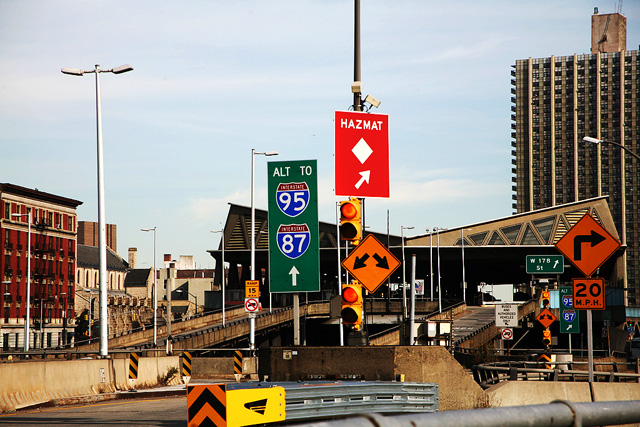
Major Deegan (ianqui)
By Joshua Colon
While on my way to see a family member recently, I took a cab and the driver decided to take a short cut on the Major Deegan Expressway, instead of the usual route I take. Once on the highway, we were soon stuck in traffic.
This is not the first time traffic on the Major Deegan has delayed my commute. I’ll probably be running late tomorrow due to this traffic.
For about the past five years, there have been construction projects after construction projects on either the surrounding streets near the Major Deegan, or the Major Deegan itself. There has also been construction on a part of the Alexander Hamilton Bridge. It appears many repairs are being made and the lanes are being expanded.
It got me wondering. “Why do these repairs and additions need to be fixed so urgently?” I accept that the bridge and expressway need to be maintained, but it seems as if there is extra work being done.
I decided to investigate. Over the past weeks I have read articles and reports about how the bridges in the United States are in pretty bad shape. One would hope that this wouldn’t be the case in a busy city like New York City, where commuting is a critical part of daily life for many.
In fact, New York City is having difficulty maintaining the region’s infrastructure.
According to the American Society of Civil Engineers, 2,169 of the 17,420 bridges in New York (approximately 12.5 percent) are considered structurally deficient. These bridges require significant maintenance, rehabilitation, or replacement. They must be inspected at least once a year since critical load-carrying elements were found to be in poor condition due to deterioration or damage.
There are approximately 1,100 bridges in New York that have been labeled as “fracture-critical.” A fracture-critical bridge is an engineering term defined as lacking “redundant supporting elements.” This much means that if a key support fails or malfunctions, the integrity of the bridge could fail, which means that the bridge could potentially end up collapsing. That would be a catastrophe in New York City where millions crossing these bridges every day.

(Doc Searle)
According to the Daily News, there are 16 bridges in the Bronx that are listed by the Federal Highway Administration as in “dire disrepair.” These include connectors on the Cross Bronx Expressway, the Major Deegan and Bronx River Parkway.
Of course, the state Department of Transportation says that these bridges are properly inspected and there is no danger, but when you see the words “fracture-critical” or “structurally obsolete,” how can you not be worried?
Busy bridges can and do collapse. In 2007, the I-35W Mississippi River Bridge, an eight-lane, steel bridge in Minneapolis collapsed during rush hour, killing 13 people.
In May of this year, the Interstate 5 bridge collapsed in northern Washington.
Weren’t the previously mentioned bridges properly inspected? Did they pass inspection? How did that work out?
Thomas Fisher, dean of the College of Design at the University of Minnesota, has studied fracture-critical bridges. In an article on democratandchronicle.com on this subject, he says that these bridges “are safe as long as they have extraordinary maintenance and attention paid to them. They work fine if everything works perfectly.”
Those are a lot of “ifs.” It is estimated that New York needs $250 billion to maintain its transportation, sewer and water systems over the next 20 years. About $80 billion is unfunded.
In an article for wgrz.com, Albany Bureau Chief Joseph Spector writes, “Fracture-critical bridges in New York are on average about 60 years old, and most bridges have a usefulness of about 50 years. Many of the fracture-critical bridges were built around World War II using a less expensive method that lacks redundancy in the design, which would provide more support for a bridge. It could mean that if one segment of the bridge falters, the whole bridge could be imperiled.”
According to the American Society of Civil Engineers, “Over 200 million trips are taken daily across deficient bridges in the nation’s 102 largest metropolitan regions. In total, one in nine of the nation’s bridges are rated as structurally deficient, while the average age of the nation’s 607,380 bridges is currently 42 years. The Federal Highway Administration (FHWA) estimates that to eliminate the nation’s bridge deficient backlog by 2028, we would need to invest $20.5 billion annually, while only $12.8 billion is being spent currently.”

Brooklyn Bridge (Carol Schaffer)
Currently, the Brooklyn Bridge is undergoing a four-year, $500 million reconstruction. On the East River, a suspension span is being renovated to accommodate about 120,000 vehicles and a crossing for thousands of pedestrians. Hundreds of steel beams are being replaced on the 82-year-old George Washington Bridge. Nearly $1 billion is being spent to renovate the 77-year-old Robert F. Kennedy Bridge which travelers take to the John F. Kennedy International Airport.
Obviously more money needs to be spent, not on building new bridges, but on renovating existing bridges to make them more structurally sound. Knowing what I do now, I would even be willing to be stuck in traffic while it’s being done.



